Ford Bronco (2022 year). Manual in english — page 15
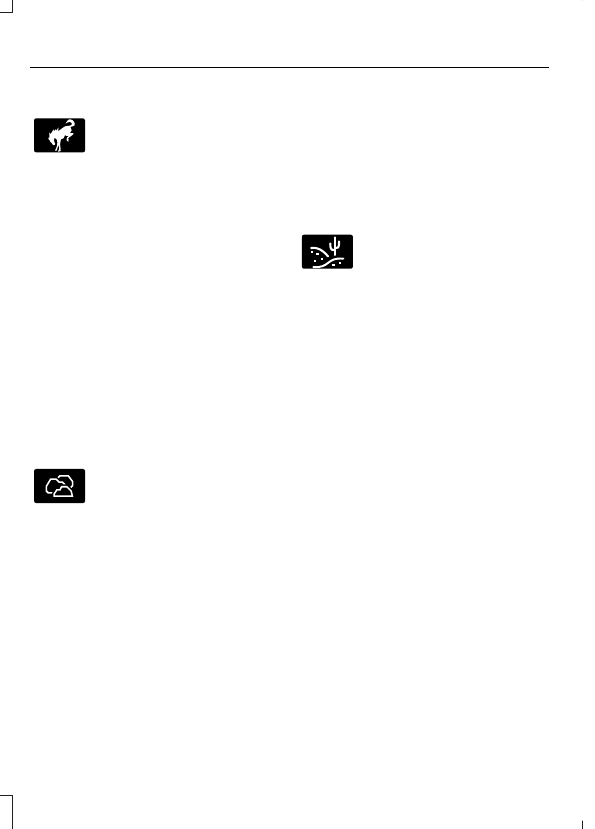
NORMAL
E317283
For everyday driving. This mode
is the perfect balance of
excitement, comfort and
convenience. This is the default mode after
each ignition cycle, the driveline settings
remain the same prior to the ignition cycle.
Two-wheel drive high (2H) is the default
four-wheel drive mode. All four-wheel drive
modes are selectable when in normal
mode.
The front electronic locking differential is
available below 25 mph (40 km/h) when
in four-wheel drive low (4L). The rear
electronic locking differential is available
below 25 mph (40 km/h).
Note:
The rear electronic locking differential
is available at any speed when in four-wheel
drive low (4L).
The stabilizer bar disconnect is available
in four-wheel drive high (4H) or four-wheel
drive low (4L).
ROCK CRAWL
E322413
For off-road driving and
optimum rock-climbing ability.
Rock crawl mode optimizes the
throttle and transmission response to
provide you additional control of your
vehicle.
Four-wheel drive low (4L) is the only
driveline configuration available in rock
crawl, the system prompts you to put your
vehicle into four-wheel drive low (4L) upon
selection.
The front electronic locking differential is
available below 25 mph (40 km/h) when
in four-wheel drive low (4L). The rear
electronic locking differential is engaged
when in rock crawl mode and is available
at any speed.
The stabilizer bar disconnects when in rock
crawl mode.
Note:
When using rock crawl mode on
dry/hard pavement, your vehicle could
experience vibration, driveline bind up,
damage and potential excessive tire and
vehicle wear.
SAND
E332185
For off-road driving on soft, dry
sand or deep snow. This mode
may help get your vehicle
unstuck from deep snow or sand.
Four-wheel drive high (4H) is the default
four-wheel drive mode. Four-wheel drive
low (4L) is selectable in sand mode.
The front electronic locking differential is
available below 25 mph (40 km/h) when
in four-wheel drive low (4L). The rear
electronic locking differential is engaged
when in sand mode and is available at any
speed in all selectable four-wheel drive
modes.
The stabilizer bar disconnect is available
in four-wheel drive high (4H) or four-wheel
drive low (4L).
Note:
The front camera system switches
on when you are in sand mode and your
speed is less than 15 mph (24 km/h). If you
exceed 15 mph (24 km/h), the camera shuts
off until your vehicle speed is below 12 mph
(20 km/h).
Note:
When using Sand mode on dry/hard
pavement, your vehicle could experience
vibration, driveline bind up, damage and
potential excessive tire and vehicle wear.
Note:
Sand mode is not intended for use
on firm, slippery surfaces, such as paved
roads covered with snow or ice. For slippery,
firm surfaces use slippery mode.
244
G.O.A.T. Mode Control
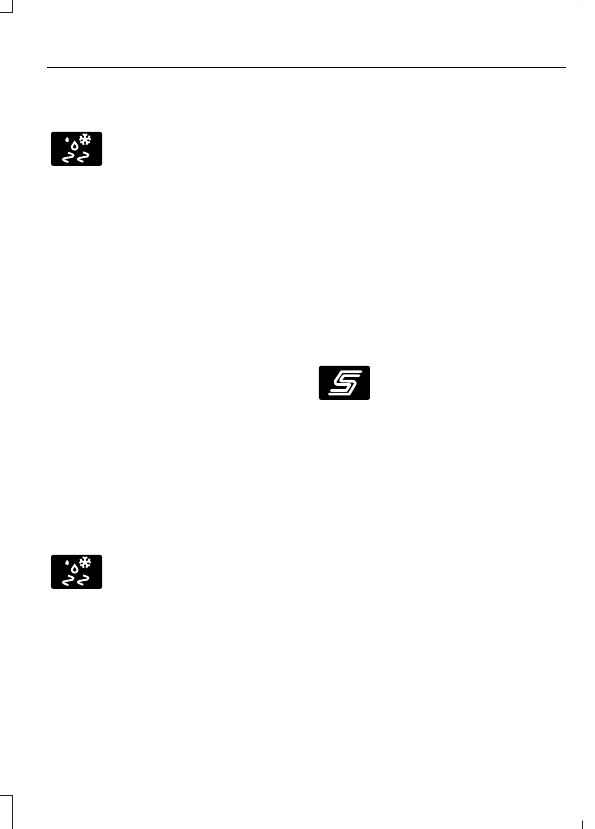
SLIPPERY - 4X4 WITH PART TIME
ENGAGEMENT
E295414
For less than ideal road
conditions, this mode can be
used for crossing terrain where
a firm surface is covered with loose or
slippery material, such as snow or ice.
Slippery mode lowers throttle response
and optimizes shifting for slippery surfaces.
Four-wheel drive high (4H) is the default
four-wheel drive mode. All four-wheel drive
modes are selectable in slippery mode.
The front electronic locking differential is
available below 25 mph (40 km/h) when
in four-wheel drive low (4L). The rear
electronic locking differential is available
below 25 mph (40 km/h).
Note:
The rear electronic locking differential
is available at any speed when in four-wheel
drive low (4L).
The stabilizer bar disconnect is not
available in slippery mode.
Note:
When using Slippery mode on
dry/hard pavement, your vehicle could
experience vibration, driveline bind up,
damage and potential excessive tire and
vehicle wear.
SLIPPERY - ADVANCED 4X4 WITH
4A MODE
E295414
For less than ideal road
conditions, this mode can be
used for crossing terrain where
a firm surface is covered with loose or
slippery material, such as snow or ice.
Slippery mode lowers throttle response
and optimizes shifting for slippery surfaces.
Four-wheel drive auto (4A) is the default
four-wheel drive mode. Two-wheel drive
high (2H) is not selectable in slippery
mode.
The front electronic locking differential is
available below 25 mph (40 km/h) when
in four-wheel drive low (4L). The rear
electronic locking differential is available
below 25 mph (40 km/h).
Note:
The rear electronic locking differential
is available at any speed when in four-wheel
drive low (4L).
The stabilizer bar disconnect is not
available in slippery mode.
Note:
When using Slippery mode on
dry/hard pavement, your vehicle could
experience vibration, driveline bind up,
damage and potential excessive tire and
vehicle wear.
SPORT - 4X4 WITH PART TIME
ENGAGEMENT
E246593
For sporty driving with improved
performance handling and
response. This mode increases
accelerator pedal response and provides
a sportier steering feel. The powertrain
system holds onto lower gears longer,
helping your vehicle accelerate faster.
Two-wheel drive high (2H) is the default
four-wheel drive mode. Four-wheel drive
low (4L) is not selectable in sport mode.
The front electronic locking differential is
not available in sport mode. The rear
electronic locking differential is available
below 25 mph (40 km/h).
The stabilizer bar disconnect is not
available in sport mode.
245
G.O.A.T. Mode Control
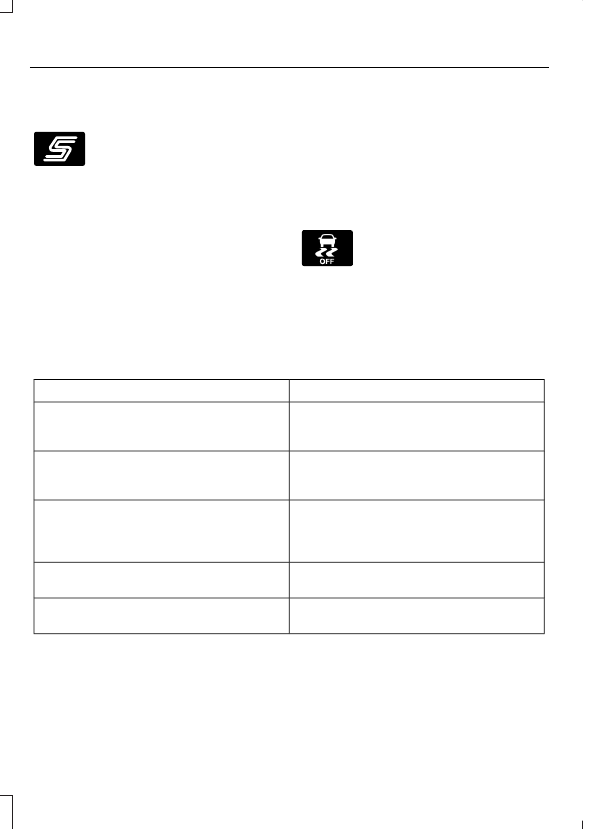
SPORT - ADVANCED 4X4 WITH 4A
MODE
E246593
For sporty driving with improved
performance handling and
response. This mode increases
accelerator pedal response and provides
a sportier steering feel. The powertrain
system holds onto lower gears longer,
helping your vehicle accelerate faster.
Four-wheel drive auto (4A) is the default
four-wheel drive mode. Four-wheel drive
low (4L) is not selectable in sport mode.
The front electronic locking differential is
not available in sport mode. The rear
electronic locking differential is available
below 25 mph (40 km/h).
The stabilizer bar disconnect is not
available in sport mode.
G.O.A.T. MODE CONTROL –
TROUBLESHOOTING
G.O.A.T. MODE CONTROL –
WARNING LAMPS
E130458
Some drive modes reduce
traction and stability control
performance and the indicator
illuminates in the instrument cluster.
G.O.A.T. MODE CONTROL – INFORMATION MESSAGES
Details
Message
Displays when the system switches to
normal mode to support towing perform-
ance.
Changing to Normal Drive Mode for
Improved Towing Performance
Displays when you select a drive mode that
is not available. Select a different drive
mode.
Drive Mode Not Available
Displays when you select a drive mode that
is not available. Check the four-wheel drive
mode, electronic locking differential and
stabilizer bar before selecting a drive mode.
Drive Mode Preconditions Not Met
Displays when you select a drive mode that
is not available. Have the system checked.
Drive Mode Selection Reduced due to
System Fault
Displays when you select an off-road drive
mode.
Off-Road Use Only
246
G.O.A.T. Mode Control
Details
Message
Displays when you select a four-wheel drive
mode that is not available in the current
drive mode. Select an available four-wheel
drive mode.
Selected 4x4 Mode Not Available in Current
Drive Mode
Displays when you select an electronic
locking differential that is not available in
the current drive mode. Select an available
electric locking differential.
Selected Locking Differential Not Available
in Current Drive Mode
Displays when you attempt to disconnect
the stabilizer bar in the current drive mode.
Select a different drive mode to disconnect
the stabilizer bar.
Sta-Bar Disconnect Not Available In
Selected Drive Mode
247
G.O.A.T. Mode Control
G.O.A.T. MODE CONTROL –
FREQUENTLY ASKED QUESTIONS
Why did the system default to normal
mode?
If a mode is unavailable due to a
system fault, normal mode is selected
and the driveline settings remain the
same as prior to the system fault.
248
G.O.A.T. Mode Control

WHAT IS THE LANE KEEPING
SYSTEM
The lane keeping system alerts you by
providing temporary steering assistance
or steering wheel vibration when it detects
an unintended lane departure.
HOW DOES THE LANE
KEEPING SYSTEM WORK
The lane keeping system uses a forward
looking camera mounted on the windshield
to monitor vehicle movement within the
travel lane.
When the camera detects a drift out of the
travel lane, the lane keeping system alerts
the driver by vibrating the steering wheel,
or aids the driver by providing a small
steering input to move the vehicle back
into the travel lane.
The driver can select one of three modes:
•
Alert (If Equipped)
•
Aid
•
Alert + Aid
LANE KEEPING SYSTEM
PRECAUTIONS
WARNING:
You are responsible for
controlling your vehicle at all times. The
system is designed to be an aid and does
not relieve you of your responsibility to
drive with due care and attention. Failure
to follow this instruction could result in
the loss of control of your vehicle,
personal injury or death.
WARNING:
The system will not
operate if the sensor cannot track the
road lane markings.
WARNING:
The sensor may
incorrectly track lane markings as other
structures or objects. This can result in
a false or missed warning.
WARNING:
In cold and severe
weather conditions the system may not
function. Rain, snow and spray can all
limit sensor performance.
WARNING:
The system may not
operate properly if the sensor is blocked.
Keep the windshield free from
obstruction.
WARNING:
If damage occurs in the
immediate area surrounding the sensor,
have your vehicle checked as soon as
possible.
WARNING:
The system may not
correctly operate if your vehicle is fitted
with a suspension kit not approved by
us.
WARNING:
Large contrasts in
outside lighting can limit sensor
performance.
LANE KEEPING SYSTEM
LIMITATIONS
The lane keeping system only operates
when the vehicle speed is greater than
40 mph (64 km/h).
The system works when the camera can
detect at least one lane marking.
The lane keeping system may not correctly
operate in any of the following conditions:
•
The lane keeping system does not
detect at least one lane marking.
•
You switch the turn signal on.
249
Lane Keeping System
(If Equipped)

•
You apply direct steering, accelerate
fast or brake hard.
•
The vehicle speed is less than 40 mph
(64 km/h).
•
The anti-lock brake, stability control or
traction control system activates.
•
The lane is too narrow.
•
Something is obscuring the camera or
it is unable to detect the lane markings
due to environment, traffic or vehicle
conditions.
The lane keeping system may not correct
lane positioning in any of the following
conditions:
•
High winds.
•
Uneven road surfaces.
•
Heavy or uneven loads.
•
Incorrect tire pressure.
SWITCHING THE LANE
KEEPING SYSTEM ON AND
OFF
E308131
To activate the lane keeping
system, press the button on the
steering wheel.
To deactivate the lane keeping system,
press the button again.
Note:
When switching the system on or off
a message appears in the information and
entertainment display to show the status.
Note:
The system stores the on or off
setting until manually changed, unless it
detects a MyKey™. If the system detects a
MyKey™, it defaults to the last setting for
that MyKey™.
Note:
If the system detects a MyKey™,
pressing the button does not affect the on
or off status of the system. You can only
change the mode and intensity settings.
SWITCHING THE LANE
KEEPING SYSTEM MODE
The lane keeping system has different
settings that you can view or adjust using
the information display.
The system stores the last known selection
for each of these settings. You do not need
to readjust your settings each time you
switch on the system.
To change the lane keeping system mode,
use the touchscreen:
1.
Select
Driver Assistance
.
2. Select
Lane Keeping System
.
3. Select
Mode
.
4. Select a setting.
Note:
The system remembers the last
setting when you start your vehicle. If the
system detects a MyKey™, the mode is set
to alert.
ALERT MODE
WHAT IS ALERT MODE
Alert mode vibrates the steering wheel
when it detects an unintended lane
departure.
250
Lane Keeping System
(If Equipped)
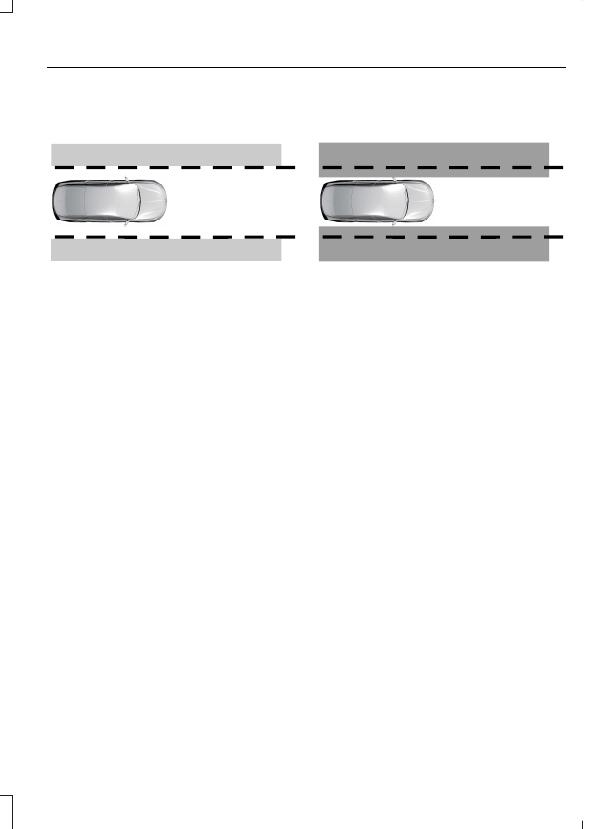
HOW DOES ALERT MODE WORK
E165515
When in alert mode, the lane keeping
system alerts you by vibrating the steering
wheel. The intensity of the vibration is set
through the lane keeping system menu.
ADJUSTING THE STEERING
WHEEL VIBRATION INTENSITY
To change the steering wheel vibration
intensity, use the touchscreen:
1.
Select
Driver Assistance
.
2. Select
Lane Keeping System
.
3. Select
Intensity
.
4. Select a setting.
AID MODE
WHAT IS AID MODE
Aid mode provides temporary steering
assistance toward the center of the lane.
HOW DOES AID MODE WORK
E165516
The lane keeping system aids you when
an unintentional lane departure occurs.
The system provides a small steering input
to move the vehicle towards the center of
the lane.
ALERT AND AID MODE
WHAT IS ALERT AND AID MODE
Alert and aid mode uses multiple features
to keep you in your lane. The system first
provides a small steering input to bring
your vehicle back towards the center of
the lane. If your vehicle moves too far out
of the center of the lane the system alerts
you with vibration in the steering wheel.
251
Lane Keeping System
(If Equipped)

HOW DOES ALERT AND AID MODE
WORK
E165517
Alert.
A
Aid.
B
The lane keeping system detects a lane
departure and provides aid when the
vehicles enters
B
and applies the
additional alert warning if
A
is entered.
LANE KEEPING SYSTEM
INDICATORS
E358269
If you switch the lane keeping system on,
a graphic with lane markings appears in
the information display.
When you switch the system off, the lane
marking graphics do not display.
Note:
The overhead vehicle graphic may
still display if adaptive cruise control is
enabled.
While the lane keeping system is on, the
color of the lane markings change to
indicate the system status.
Red
Yellow
Green
Gray
Indicates that the
system is providing
or has just provided
a lane keeping alert
warning.
Indicates that the
system is providing
or has just provided
a lane keeping aid
intervention.
Indicates that the
system is available
or ready to provide a
warning or interven-
tion on the indicated
side.
Indicates that the
system is tempor-
arily unavailable to
provide a warning or
intervention on the
indicated side.
252
Lane Keeping System
(If Equipped)
LANE KEEPING SYSTEM – TROUBLESHOOTING
LANE KEEPING SYSTEM – INFORMATION MESSAGES
Action
Message
The system has malfunctioned. Have your
vehicle checked as soon as possible.
Lane Keeping Sys. Malfunction Service
Required
The system has detected a condition that
has caused the system to be temporarily
unavailable.
Front Camera Temporarily Not Available
The system has detected a condition that
requires you to clean the windshield in order
for it to operate properly.
Front Camera Low Visibility Clean Screen
The system has malfunctioned. Have your
vehicle checked as soon as possible.
Front Camera Malfunction Service Required
The system requests that you keep your
hands on the steering wheel.
Keep Hands on Steering Wheel
253
Lane Keeping System
(If Equipped)

LANE KEEPING SYSTEM – FREQUENTLY ASKED QUESTIONS
Why is the feature not available (lane markings are gray) when I can see the lane markings
on the road?
Your vehicle speed is less than 40 mph (65 km/h).
The sun is shining directly into the camera lens.
A quick intentional lane change has occurred.
Your vehicle stays too close to the lane markings for an extended interval of time.
Driving at high speeds in curves.
The last alert warning or aid intervention occurred a short time ago.
Ambiguous lane markings, for example, in construction zones.
Rapid transition from light to dark, or from dark to light.
Sudden offset in lane markings.
ABS or AdvanceTrac™ is active.
There is a camera blockage due to dirt, grime, fog, frost or water on the windshield.
You are driving too close to the vehicle in front of you.
Transitioning between no lane markings to lane markings, or vice versa.
There is standing water on the road.
Faint lane markings, for example, partial yellow lane markings on concrete roads.
Lane width is too narrow or too wide.
You have not calibrated the camera after a windshield replacement.
Driving on tight or on uneven roads.
254
Lane Keeping System
(If Equipped)
Why does the vehicle not come back toward the middle of the lane, as expected, in the
Aid, or Aid + Alert mode?
High cross winds are present.
There is a large road crown.
Rough roads, grooves or shoulder drop-offs.
Heavy, uneven loading of the vehicle or improper tire inflation pressure.
You changed the tires or modified the suspension.
255
Lane Keeping System
(If Equipped)
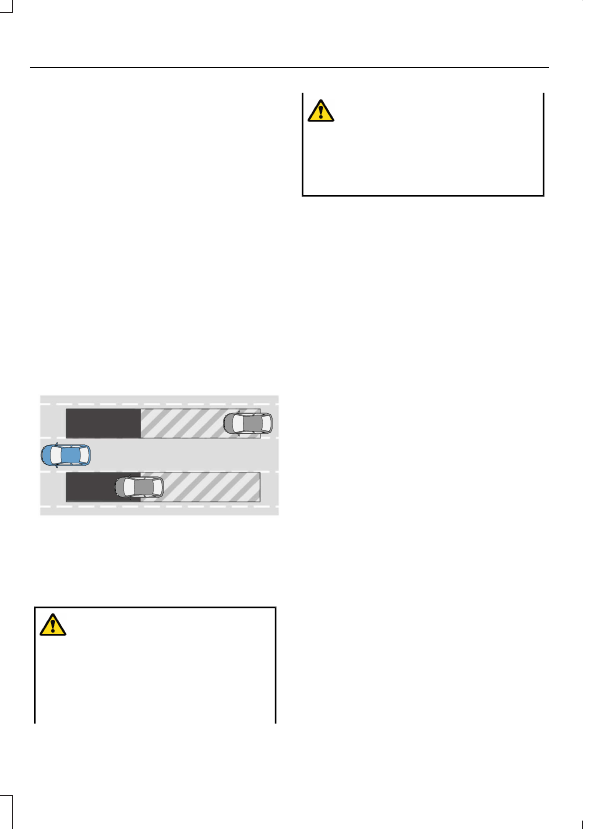
WHAT IS BLIND SPOT
INFORMATION SYSTEM
Blind spot information system detects
vehicles that may have entered the blind
spot zone.
HOW DOES BLIND SPOT
INFORMATION SYSTEM WORK
Blind spot information system uses
sensors on both sides of your vehicle,
detecting rearward from the exterior
mirrors to approximately 13 ft (4 m)
beyond the rear bumper. The detection
area extends to approximately 59 ft (18 m)
beyond the rear bumper when the vehicle
speed is greater than 30 mph (48 km/h)
to alert you of faster approaching vehicles.
E255695
BLIND SPOT INFORMATION
SYSTEM PRECAUTIONS
WARNING:
Do not use the blind
spot information system as a
replacement for using the interior and
exterior mirrors or looking over your
shoulder before changing lanes. The
blind spot information system is not a
replacement for careful driving.
WARNING:
The system may not
operate properly during severe weather
conditions, for example snow, ice, heavy
rain and spray. Always drive with due
care and attention. Failure to take care
may result in a crash.
Note:
Blind spot information system does
not prevent contact with other vehicles. It
does not detect parked vehicles,
pedestrians, animals or other infrastructure.
BLIND SPOT INFORMATION
SYSTEM LIMITATIONS
Blind spot information system does not
operate in park (P) or reverse (R).
The system may not alert you if a vehicle
quickly passes through the detection zone.
BLIND SPOT INFORMATION
SYSTEM REQUIREMENTS -
MANUAL TRANSMISSION
The blind spot information system turns
on when all the following occur:
•
You start your vehicle.
•
You shift into neutral or any forward
gear.
•
The vehicle speed is greater than
6 mph (10 km/h).
256
Blind Spot Information System
(If Equipped)

BLIND SPOT INFORMATION
SYSTEM REQUIREMENTS -
AUTOMATIC TRANSMISSION
Blind spot information system turns on
when all the following occur:
•
You start your vehicle.
•
You shift into drive (D).
•
The vehicle speed is greater than
6 mph (10 km/h).
SWITCHING BLIND SPOT
INFORMATION SYSTEM ON
AND OFF
To switch blind spot information system
on or off, use the touchscreen:
1.
Press
Features
on the touchscreen.
2. Press
Driver Assistance
.
3. Press
Blind Spot Information System
.
4. Switch the feature on or off.
When you switch blind spot information
system off, a warning lamp illuminates and
a message displays. When you switch the
system on or off, the alert indicators flash
twice.
Note:
The system remembers the last
setting when you start your vehicle.
To permanently switch the system off,
contact an authorized dealer.
LOCATING THE BLIND SPOT
INFORMATION SYSTEM
SENSORS
E339014
The sensors are behind the rear fascia
panel.
Note:
Keep the sensors free from snow, ice
and large accumulations of dirt.
Note:
Do not cover the sensors with bumper
stickers, repair compound or other objects.
Note:
Bike and cargo racks could cause
false alerts due to obstruction of the sensor.
We recommend switching the feature off
when using a bike or cargo rack.
Note:
Blocked sensors may affect system
accuracy.
If the sensors become blocked, a message
appears in the instrument cluster display.
See
Blind Spot Information System –
(page 258). The
alert indicators illuminate but the system
does not alert you.
257
Blind Spot Information System
(If Equipped)

BLIND SPOT INFORMATION
SYSTEM INDICATORS
E142442
E249861
E249861
When blind spot information
system detects a vehicle, an
alert indicator illuminates in the
exterior mirror on the side the approaching
vehicle is coming from. If you turn the turn
signal on for that side of your vehicle, the
alert indicator flashes.
BLIND SPOT INFORMATION SYSTEM – TROUBLESHOOTING
BLIND SPOT INFORMATION SYSTEM – INFORMATION MESSAGES
Action
Message
A fault with the system has occurred. Have
your vehicle checked as soon as possible.
Blind Spot System Fault
Something is blocking the sensors. Clean
the sensors.
Blind Spot Not Available Sensor Blocked
See Manual
The system automatically turns off and
displays this message when you connect a
trailer to the vehicle that does not have a
trailer blind spot system or when you switch
the trailer blind spot system off through the
touchscreen.
Blind Spot Alert Deactivated Trailer
Attached
258
Blind Spot Information System
(If Equipped)
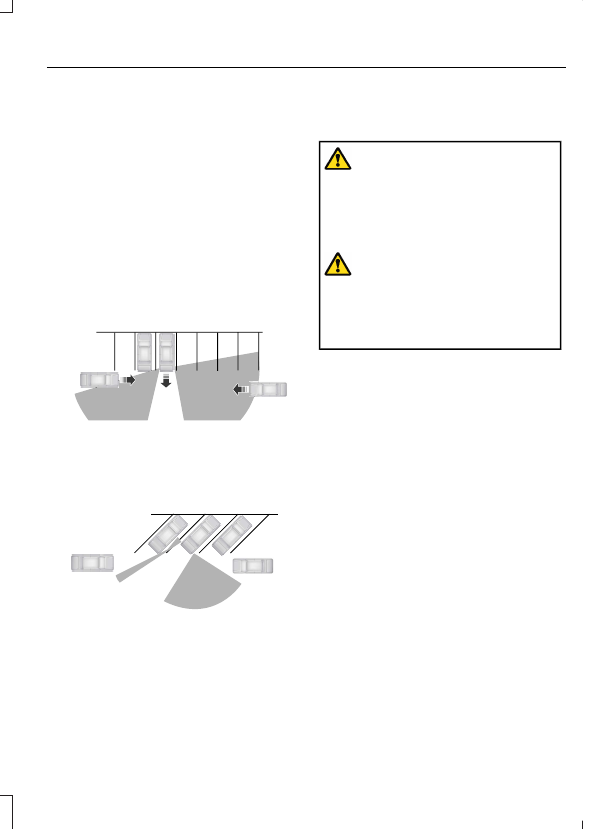
WHAT IS CROSS TRAFFIC
ALERT
The system alerts you of vehicles
approaching from the sides behind your
vehicle when you shift into reverse (R).
HOW DOES CROSS TRAFFIC
ALERT WORK
Cross traffic alert detects vehicles that
approach at a speed between 4–37 mph
(6–60 km/h). Coverage decreases when
the sensors are partially, mostly or fully
obstructed.
E142440
The sensor on the left-hand side is only
partially obstructed and zone coverage on
the right-hand side is maximized.
E142441
Zone coverage also decreases when
parking at narrow angles. The sensor on
the left-hand side is mostly obstructed and
zone coverage on that side is severely
reduced.
Note:
Slowly reversing helps increase the
coverage area and effectiveness.
CROSS TRAFFIC ALERT
PRECAUTIONS
WARNING:
Do not use the cross
traffic alert system as a replacement for
using the interior and exterior mirrors or
looking over your shoulder before
reversing out of a parking space. The
cross traffic alert system is not a
replacement for careful driving.
WARNING:
The system may not
operate properly during severe weather
conditions, for example snow, ice, heavy
rain and spray. Always drive with due
care and attention. Failure to take care
may result in a crash.
CROSS TRAFFIC ALERT
LIMITATIONS
Cross traffic alert may not correctly
operate when any of the following occur:
•
Something is blocking the sensors.
•
Adjacently parked vehicles or objects
are obstructing the sensors.
•
Vehicles approach at speeds less than
4 mph (6 km/h) or greater than 37 mph
(60 km/h).
•
Your vehicle speed is greater than
7 mph (12 km/h).
•
You reverse out of an angled parking
space.
SWITCHING CROSS TRAFFIC
ALERT ON AND OFF
To switch cross traffic alert on or off use
the touchscreen.
1.
Press
Features
on the touchscreen.
2. Press
Driver Assistance
.
259
Cross Traffic Alert
(If Equipped)

Нет комментариевНе стесняйтесь поделиться с нами вашим ценным мнением.
Текст